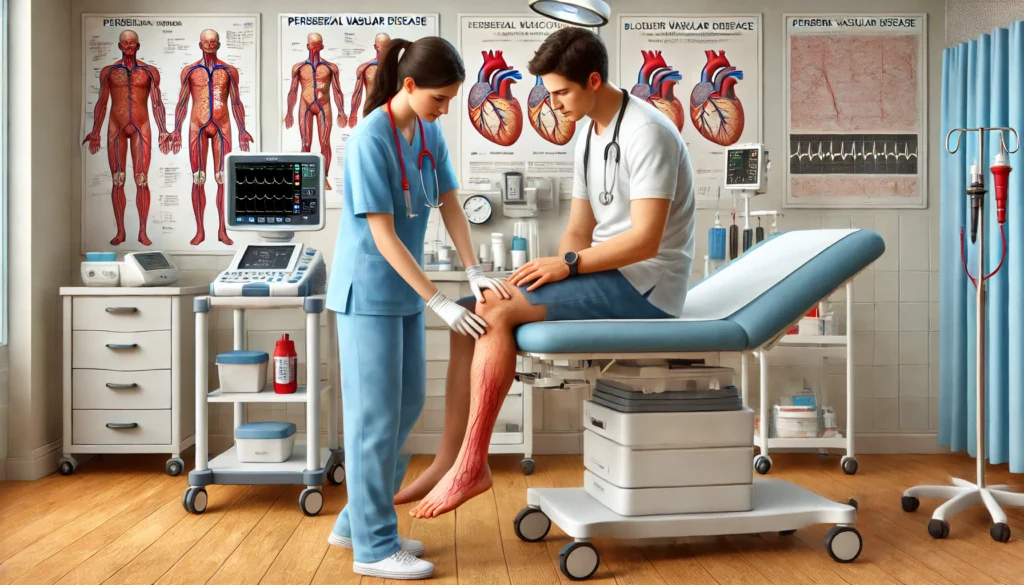Peripheral Vascular Disease (PVD) is a common yet often underdiagnosed condition affecting the arteries and veins outside the brain and heart. It occurs when blood flow to the limbs is reduced, leading to complications such as pain, numbness, and in severe cases, amputation. PVD nursing care plan is crucial for managing the symptoms, preventing complications, and improving the patient’s quality of life. Nurses play a pivotal role in assessing, planning, and implementing nursing interventions to address the complexities of PVD.
Thank you for reading this post, don't forget to subscribe!
The management of PVD involves comprehensive care that includes lifestyle modifications, medication management, pain control, and education. Nurses are responsible for assessing the severity of the condition through various diagnostic tests, monitoring vital signs, and providing the patient with appropriate care to reduce discomfort and prevent further progression of the disease.
A PVD nursing care plan should prioritize effective circulation, pain relief, and education on managing risk factors such as smoking, obesity, and hypertension. This plan should include regular assessments of blood pressure, peripheral pulses, and skin integrity to monitor changes in the patient’s condition. The goal is to minimize complications like tissue damage, ulcerations, or even gangrene, while also enhancing the patient’s functional capacity.
In this article, we will provide a PVD nursing care plan example that focuses on nursing assessments, diagnoses, interventions, and expected outcomes, offering a comprehensive approach for nurses working with patients suffering from this condition. Through effective management, nurses can significantly improve the prognosis for individuals with PVD.
Patient Information (Please note, the information presented here is fictional.)
- Name: Jane Smith
- Age: 58 years
- Gender: Female
- Medical History: Type 2 diabetes, hypertension, and a history of smoking (20-pack years)
- Type of Condition: Peripheral Vascular Disease (PVD)
- Symptoms: Intermittent claudication, cold extremities, tingling sensations in the legs, and visible varicose veins. She reports pain in the lower legs while walking that improves with rest.
- Medical Diagnosis: Peripheral Vascular Disease (PVD)
- Admission Date: January 5, 2025
- Care Plan Initiation Date: January 6, 2025


Nursing Care Plan for PVD
The PVD nursing care plan focuses on interventions aimed at improving circulation, relieving pain, and preventing further complications. Below is a sample nursing care plan for a patient diagnosed with PVD.
Nursing Assessment
| Subjective Data | Objective Data |
|---|---|
| Patient reports pain in legs, especially while walking | Pale, cold extremities with reduced hair growth |
| Complaints of numbness and tingling sensation | Peripheral pulses weak or absent in the lower extremities |
| Reports intermittent claudication that improves with rest | Systolic blood pressure of 150/90 mmHg (elevated) |
| Describes fatigue and difficulty walking long distances | Skin discoloration and possible ulceration on the toes |
| Denies any chest pain or shortness of breath | A history of smoking and obesity |
Vital Signs:
- Blood pressure: 150/90 mmHg (Hypertension)
- Heart rate: 80 bpm (Normal)
- Respiratory rate: 18 breaths/min (Normal)
- Temperature: 36.8°C (Normal)
Hydration Status:
- Mucous membranes appear moist but pale.
- No signs of dehydration or edema present.
Pain Assessment:
- Pain scale: 6/10 (moderate to severe) in the lower legs, worse during physical activity.
- Pain localized to the calves and thighs.
Laboratory Values:
- HbA1c: 8.1% (elevated, indicating poor diabetic control)
- Cholesterol levels: High LDL (160 mg/dL), Low HDL (35 mg/dL)
Nursing Diagnosis
- Ineffective Peripheral Tissue Perfusion related to reduced blood flow as evidenced by pale, cold extremities and intermittent claudication.
- Chronic Pain related to insufficient circulation as evidenced by patient’s report of pain and discomfort in the legs during activity.
- Imbalanced Nutrition: More Than Body Requirements related to poor dietary habits and obesity as evidenced by high cholesterol and BMI.
- Deficient Knowledge related to disease process and management of PVD as evidenced by lack of understanding about lifestyle modifications.
- Risk for Impaired Skin Integrity related to reduced circulation and existing skin discoloration and ulcerations.
Nursing Interventions and Rationales
- Monitor and assess peripheral pulses in both lower extremities every shift.
- Rationale: Monitoring peripheral pulses allows early detection of any further reduction in circulation, which may necessitate intervention.
- Administer prescribed medications, including antiplatelet agents (e.g., aspirin) and statins for cholesterol management.
- Rationale: Medications help manage risk factors like hypertension, hyperlipidemia, and improve circulation by preventing clot formation.
- Encourage regular physical activity (e.g., walking or leg exercises) to improve circulation.
- Rationale: Physical activity promotes blood flow to the lower extremities and can alleviate symptoms like claudication.
- Promote smoking cessation and provide resources for quitting (nicotine patches, counseling, etc.).
- Rationale: Smoking is a major risk factor for PVD, and quitting can slow disease progression and improve circulation.
- Educate the patient on the importance of proper nutrition, including low-fat, low-sodium, and low-sugar diets.
- Rationale: Proper diet management can reduce obesity and improve control over diabetes and cholesterol levels, mitigating PVD progression.
- Ensure proper wound care and monitor for signs of skin breakdown if any ulcers or discoloration develop.
- Rationale: Proper skin care helps prevent infections and further complications such as gangrene.
Nursing Goals
- Goal 1: The patient will report a decrease in leg pain (pain score of 3 or lower) within 48 hours of intervention.
- Goal 2: The patient will demonstrate an understanding of lifestyle modifications to manage PVD, as evidenced by verbalizing key points during education sessions within 72 hours.
- Goal 3: The patient’s peripheral pulses will be palpable in both lower extremities within 1 week.
- Goal 4: The patient will achieve improved control of cholesterol levels (LDL < 100 mg/dL) and HbA1c levels within 3 months.
- Goal 5: The patient will experience no further deterioration of skin integrity and will show no signs of new ulcerations or lesions in the lower extremities within 1 month.
Evaluation and Expected Outcomes
- Outcome 1: The patient reports reduced leg pain and increased mobility, evidenced by a pain scale rating of 3/10 or lower.
- Outcome 2: The patient demonstrates knowledge of dietary changes, smoking cessation, and the importance of regular exercise by articulating these practices during follow-up visits.
- Outcome 3: Peripheral pulses in both lower extremities return to a normal, palpable state within 7 days, indicating improved circulation.
- Outcome 4: Laboratory results show improvements in cholesterol and glucose management, with LDL levels <100 mg/dL and HbA1c below 7%.
- Outcome 5: No new signs of skin ulceration or discoloration are present in the lower extremities, indicating the successful prevention of further complications.
FAQs
- What is Peripheral Vascular Disease (PVD)?
- PVD is a condition that involves narrowing or blockages in the blood vessels outside of the heart and brain, often leading to reduced circulation, pain, and potential tissue damage.
- How is PVD treated?
- Treatment for PVD involves lifestyle changes (like smoking cessation, exercise, and diet), medications to improve circulation, and sometimes surgical interventions, such as angioplasty.
- What are the early signs of PVD?
- Early signs of PVD include leg pain during physical activity (intermittent claudication), cold extremities, and visible varicose veins or discoloration.
- Can PVD be reversed?
- While PVD cannot be fully reversed, it can be managed effectively with lifestyle changes and medications to prevent further complications.
- How can I prevent PVD?
- Prevention includes maintaining a healthy diet, exercising regularly, quitting smoking, and managing health conditions such as diabetes, hypertension, and high cholesterol.


